
Physical geography Chapter 4: Rocks

Mineral
A mineral is a naturally occurring substance which has certain physical properties and a definite chemical composition
Rock
A rock is an aggregate of mineral particles forming part of earth crust. Rocks differ in shape, size, color and texture.
Types of rocks
The three types of rocks are Igneous Rock, Sedimentary Rock, and Metamorphic Rock according to the mode of formation
Igneous/formed rocks
Igneous rocks are fine formed rocks due to vulcanicity. They are formed when molten magma cools and becomes a solid. They can form either on the surface (extrusive igneous rocks), or deep in the crust (intrusive or plutonic igneous rocks).
The process responsible for the formation of igneous rocks in East Africa
Igneous rocks are fire formed rocks. The main process of formation is vulcanicity. This is the process by which molten rock (magma/lava) cools down, crystallizes and solidifies either within the earth’s crust to form intrusive rocks or onto the surface of the earth to form extrusive rocks.
Vulcanicity originates from the interior of the earth due to radio activity, geochemical reactions and connectivity within the mantle – a lot of heat is generated that melts the rocks in the mantle creating convective currents. These currents exert pressure on crustal rocks creating lines of weakness/ fissures through which molten rocks is either intruded or extruded.
Igneous rocks are categorized according to rate of cooling/depth and chemical composition.
Igneous rocks according to rate of cooling and depth they include;
- Plutonic rocks/ Abyssal rocks:
- These are formed from cooling and solidification of magma at great depth hence they are deep seated rocks.
- The intruded magma cools and solidifies extremely due to lack of contact with air leading to formation of rocks with large crystals such as granite, gabbro, diorite, synite etc.
- These rocks are found in features such as exposed batholith at Mubende, Singo etc.
- Hypabyssal/intermediate rocks:
- These are formed from magma that cools and solidifies near the surface of the earth/shallow depth. The rate of cooling is moderate leading to formation of medium sized crystals e.g. Quartz, dolerite, porphyry, etc.
- They are found in features such as dykes in Turkana land etc.
- Volcanic rocks/extrusive rocks:
- are formed from fast cooling of lava extruded onto the surface of the earth due to exposure to air leading to the formation of rocks that have very small crystal e.g. obsidian, basalt, andesite, pumice etc.
- Some of the volcanic rocks are spongy in nature such as pumice due to enclosure of gases at cooling time.
- Some rocks are glassy in appearance such as obsidian.
- Some rocks are dark coloured such as Basalt.
- Volcanic rocks are mainly found in features such as volcanic mountain e.g. Elgon, lava plateaus such as Yatta etc.
Igneous rocks according to chemical composition:
Magma/ lava vary in chemical composition and so has an effect on its viscosity/thickness which in turn influences the rate of cooling and the process of crystallization. In this category the rocks include;
- Acidic/felsic rocks: these have a high content of silica (65%) and 35% or less basic oxides. They are light coloured, have low density e.g. granite, diorite, Rhyolite, Andesite etc.
- Intermediate rocks have moderate silica content between 55- 65% and 45-35% basic oxides. They are a mixture of mineral structure of acidic and basic e.g. poryphyites.
- Basic rocks contain much mica and olivine. They are rich in iron and magnesium. They are dark coloured, dense or heavy, have low silica content between 45-55% and 55- 45% basic oxide
Igneous rocks are generally characterized by the following:
- They are crystalline in structure
- They do not contain fossils.
- Some are spongy in nature such as Pumice.
- Some are dark coloured such as Basalt
- They do not occur in layers/strata
- Some are acidic, basic and intermediate in chemical composition etc.
- They are concentrated in areas of crustal instability and vulcanicity such as rift valley
Examples of igneous rocks include; Granite, Quam, Gabbro, Pumice, Basalt, Obsidian, Dolerite, diorite etc.
Importance of igneous rocks
Positive importance of igneous rocks
- Polished granite is commonly used to make countertops.
- Basalt is a main rock in the construction industry. It is an ingredient in concrete.
- Pumice is also an ingredient in lightweight construction materials.
- Breakdown to form fertile soils
- Contain mineral such as diamond in Tanzania
- Form water falls used for generation of hydroelectricity and tourist attraction
- Influence supply of water in spring wells
- Igneous rocks formed highlands like Mt. Kilimanjaro that support different plant and wildlife
Negative importance of igneous rocks
- Igneous rocks such as granite are hard and take long to weather to produce soil that support agriculture e.g. at Turkana land in Kenya.
- Igneous rocks form highlands that shield rain on leeward side such as that of Mt. Elgon and Mt. Kilimanjaro
- Igneous rocks form highlands that limit transport and communication such as in Kabale-Kisoro region in Uganda.
- Igneous rocks form highlands that experience land slide destroying property and lives such as on Mt. Elgon
- Igneous rocks are formed through volcanic eruption that release hot magma and gases that destroy property and life such as Nyamulangira in DR Congo
Sedimentary rocks
Sedimentary rocks are rocks that are composed of particles of rocks that have been deposited in layers by water, wind or moving ice.
They are characterized by the following;
- They are stratified /occur in layers
- They contain fossil.
- They are non-crystalline in nature
- The layers are separated by bedding planes.
- The strata are either, horizontal, gently sloping or steeply dipping.
- They are concentrated around water bodies e.g. Indian Ocean, Lake Victoria and L. Albert
Examples include; Sandstone, mudstone, clay, rock salt; coral, limestone, dolomites, soda ash, gypsum, iron ore, iron stone, etc.
Importance of sedimentary rocks
Positive importance of sedimentary rocks
- Sand and gravel are used to make concrete n construction industry
- Limestone for marking cement
- Shale is used as a component in cement production
- It is important in the formation of beaches, spits, sand bars and estuaries and provides substrates for aquatic plants and animals.
- It provides nutrients and minerals vital to the health of downstream ecosystems.
- Rock gypsum is used to make plaster.
- Natural gas, oil, coal, uranium, and other energy resources are formed in and come from sedimentary rocks.
- Provide materials for brick making e.g. clay at Kajansi for making tiles
Negative importance of sedimentary rocks
- Form immature soils that are unproductive e.g. in Semuliki basin and coastal areas of Mombasa.
- Form vast wastelands due to coarse sedimentary deposits e.g. sand dunes
- Sedimentary rocks such as coral reefs are barrier to shipping at Mombasa.
- Sedimentary rocks tend to influence flooding due to fine silt and clay materials
- They are associated with infertile soils due to leaching.
Metamorphic rocks
They are formed when igneous rocks or sedimentary rocks are subjected to great heat and high pressure for a very long time
Characteristics of metamorphic rocks
- Crystalline and often have a “squashed” (foliated or banded) texture.
- Rarely have fossils.
- May have alternate bands of light and dark minerals.
- May be composed of only one mineral, e.g., marble & quartzite.
- Very hard
- Usually made of mineral crystals of different sizes.
- Rarely have pores or openings.
- They are the oldest rocks in East Africa
Examples are Slate, schist, gneiss, quartzite and marble.
Importance of metamorphic rocks
Positive importance of metamorphic rocks
- Metamorphic rocks such as marble are used in construction
- Valuable minerals such as Mica in Northern Uganda, diamond in Mwadui in Tanzania and copper in Kilembe mine occur in metamorphic rocks
- Form strong basements for tunnel and dam construction
- Act as aquifer water source for example Artesian wells in Sudan and Kenya
- Used as grinding stones
- For study purpose
Negative importance of metamorphic rocks
- Take very long to weather.
- Generally yield poor soils
- They are barrier to transport
- Metamorphic rocks form highlands that experience landslides.
Influence of igneous rocks on landform development in East Africa
In East Africa Igneous form
- Extrusive volcanic features such Ash and cinder cones. Composite cones/strato volcanoes, Shield volcanoes, Lava plateaus, Volcanic plug, Volcanic neck, Cumulo dome, Caldera. Hot springs, Geysers and Fumaroles.
- Intrusive volcanic features; Batholiths, Inselbergs, Dykes, Ridges, Sills, Laccoliths, Uplands.
These were fully discussed in chapter 3 i.e. vulcanicity in East Africa
Extrusive features formed by vulcanicity include the following
These are volcanic features formed from molten material magma that has flowed out of cracks in the Earth’s surface.
Ash and cinder cones
These are small steep sided cone shaped hills usually less than 200m formed by very violet eruption of many fragments of various sizes with ash being smaller than cinder. They gradually build layers of a conical hill with a bowl-shaped crater at the top.
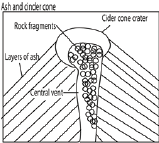
Examples in East Africa include Teleki, Likaiyu, in Kenya and Muganza, sagitwe in Uganda
Composite volcanic cones/strato volcanoes
These are usually large volcanic cones with fairly steep slopes. They are made of alternate layers of ash and lava ejected through a central vent over a long period of time. Each layer of lava over ash represents a phase of eruption.
Examples of composite cones/ strato volcanoes are Mt. Kilimanjaro, Meru, Mt Mubabura on Uganda – Rwanda border.
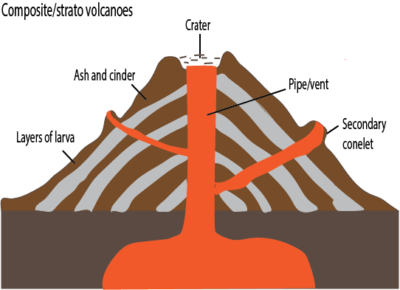
A shield volcano is a broad volcano with sloping sides that is formed mainly out of runny lava that flows out of its central/multiple fissures.
They are built by repeated eruptions that occurred intermittently over vast periods of time (up to a million years or longer). Shield volcanoes are much wider than they are tall. Examples include Nyamulangira volcano in Eastern DR Congo.
Lava plateaus
A lava plateau is upland with more or less monotonous relief and formed by different or successive layers of lava.
It’s formed by a quiet eruption that basic and therefore fluid lava flows out through several fissures/cracks in the earth crust and spreads out over a long distance covering any original valleys and hills on the landscape before solidifying as a sheet of basalt. Repeated fissure eruptions lead to the building of thick and high plateau which may reach 6000feet high.
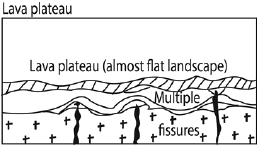
Examples include the Laikipia plateau on the eastern slopes of the Aberadare ranges in in Kenya, Yatta plateau, Kisoro lava plateau, etc.
Volcanic plug
Volcanic plugs are very steep sided volcanic features that stand out prominently above the ground. Volcanic plug is formed by a very explosive eruption where viscous magma is extruded out as a rigid cylindrical mass amidst clouds of hot ash and cinders
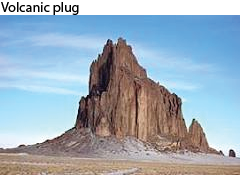
Volcanic neck
Volcanic neck was formed when lava solidified in the vent of a volcano and later exposed by the erosion of the surrounding cone.
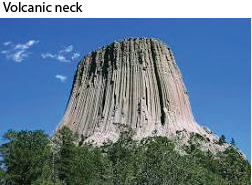
Examples include; Mawenzi peak on Mt. Kilimanjaro, Batian and Nelion peaks on Mt Kenya, etc.
Cumulo dome
Cumulo dome is a steep-sided mound that is formed when lava reaching the Earth’s surface is so viscous that it cannot flow away readily and accumulates around the vent.
When it forms into a crater, it is called a Thalloid or wizard Island.
Examples are Ntumbi cumulo dome in Tanzania, Gombe and Nakasongola domes in Uganda. In Kenya, they are found in the Tsavo National Park, Thalloids are found in a Caldera on top of Mt Rungwe in Tanzania.
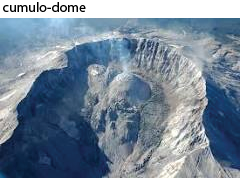
Caldera
A caldera is a depression created after a volcano partially collapses after releasing the majority of its magma chamber in an explosive eruption. e.g. Ngorongoro
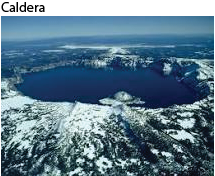
Hot springs, Geysers and Fumaroles
Hot springs are springs with water at temperatures substantially higher than the air temperature of the surrounding region.
Most hot springs discharge groundwater that is heated by shallow intrusions of magma (molten rock) in volcanic areas or rocks heated by radioactivity or geochemical reaction.
Examples are found at Kitagata and Sempaya, Rwagimba, Ilimbo and Kisizi in Uganda. Majimoto in Tanzania, etc.
Geyser involves periodical ejection of steam and hot water from the country rocks. They are formed when rain water seeps underground through small fissures and collects in an underground cavity on super-heated rock due to radioactivity. As the water is boiled up by the superheated rocks, steam and pressure powerfully pushes jets of water and steam through the thin or narrow openings. The water on top again seeps down and the same process is periodically repeated. Examples of geyser are found at L. Bogoria in Kenya. In U.S.A the “Old faithful” geyser in the Yellow stone national park erupts regularly every after thirty minutes.

Fumaroles are openings in the earth’s surface that emit steam and volcanic gases, such as sulfur dioxide and carbon dioxide. Examples are found in the craters of Mt. Kilimanjaro, Mt. Longonot in Kenya rift valley.
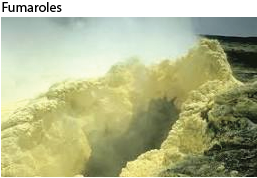
Intrusive volcanic features
These are volcanic features formed when magma solidify within the earth crust. They include
Batholiths
A batholith is a very large dome shaped intrusions of igneous rock that forms when magma rises into the earth’s crust, but does not erupt onto the surface.
Batholiths are normally composed of hard and resistant granite rocks but may be exposed by denudation process such as erosion and weathering.
Examples of Batholiths are Mubende Batholith, Nakasongola, Luwero and Singo Batholiths. In Kumi there is Kachumbala Batholith, and Kakamaya in Kenya. In Tanzania they are found at Mwanza (Bismack rock) and Sukuma land.
Inselbergs
An inselbergs is an isolated hill of hard volcanic rocks that has resisted denudation processes such as erosion and weathering.

Examples include exposed batholiths in Mubende, Singo, Parabong, Nakasongola, Labwor hills, kyenjojo, between Iringa and Mwanza in Tanzania etc.
Dykes.
- These are vertical (wall -like) or steeply inclined igneous rock structures, cutting across rock strata.
- They were formed from intrusion of magma solidifying into igneous rock structure along vertical fissures/ lines of weaknesses.
- They vary from few centimeters to hundreds of meters.
- They are always discordant cutting across the bedding planes of rock strata/ preexisting intruded rocks rock
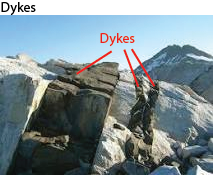 .
.
Ridges
A ridge is a long, narrow, elevated geomorphologic landform, structural feature, or a combination of both separated from the surrounding terrain by steep sides, like ridges such as those in Busia, Sukulu, Isingiro, Kisumu, Rungwa complex etc.
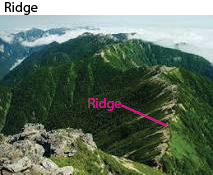
Trenches
- When soft dykes in compression with neighboring hard rocks may be worn away forming trenches (long narrow ditch like depressions) on the surface e.g. linear trenches near Lake Turkana, in Kenya
Sills
- These are horizontal sheets of igneous rock structure lying between the bedding planes.
- Formed when magma rises, spreading horizontally and solidifying between the bedding planes of rock strata.
- Vary in thickness and may extend for many km. When exposed by denudation they form flat topped
- hills, cliffs
- Where sills are hard compared to soft surrounding rocks, they are exposed forming flat topped hills, escarpments or cliffs as relief land forms e.g. kakinzi in Luwero, Thika district ( thika falls as sills are crossed by rivers) in kenya etc.
Laccoliths
- These are dome shaped intrusive igneous rock structures with a flat base
- They are formed from injection of vicious magma into the layers unable to spread far, accumulating in a large mass.
- The vicious magma forced the overlying rock strata to bend upwards hence dome shaped as it solidified
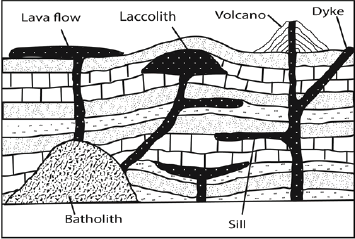
Uplands
- When exposed by denudational forces, laccoliths have formed uplands when harder than the surrounding rocks e.g. Kitui, Voi areas in Kenya etc.
Influence of Rock structure on the development of drainage patterns in East Africa.
The aspects of rock such as rock hardness, rock jointing, rock dip, stratification, mineralogical composition, homogeneity, rock heterogeneity had a big influence on the development of different drainage patterns in many ways. These include:
- Rectilinear or Trellis drainage pattern
- It is a drainage system were tributaries join the main stream at approximately right angle (900).
- It forms in areas of jointed and faulted rocks or areas of alternate soft and hard rocks demarcated by joints at approximately 900.
- Erosion of soft rocks guided by the fault lines or joints leaves channels through rivers flow.
- Examples occur on R. Mayanja- Kato, Wasswa in Kichwamba, R. Aworanga, Pager, Aswa, Tiva and Galana,
- Parallel drainage pattern
- A parallel drainage pattern consists of rivers and streams that run parallel to each other.
- It is formed in areas of alternate bands of soft and hard rocks lying side by side.
- Soft rocks are eroded to form the river channels while the hard rocks resist erosion to form a divide which limit chances of adjacent rivers joining each other.
- Examples include R. Nkusi and R. Hoima flow parallel to each other before joining L. Albert in Uganda and tributaries of River Athi such as R. Nairobi, Thirika, Komu and Ruiru flow parallel to each other in Kenya
- Dendritic and radial drainage patterns.
- Dendritic drainage pattern is pattern where tributaries join the main stream at angles less than 900.
- Dendritic and radial drainage patterns are formed in areas of Homogeneous or crystalline igneous rocks
- Uniformity of the rock structure enables the rivers to erode any region with minimum effort thus creating a variety of tributaries.
- Example are found on R. Rufigi, Victoria Nile, R. Malagalasi. Ruvuma in Tanzania and River Nyando.
- Radial drainage pattern
- Radical pattern is a type of drainage pattern which develops when streams flow in different directions from a central peak or dome like structure.
- It forms in areas of steeply dipping rock for instance from the tip of volcanic mountains.
- Examples of radial patterns are found on Elgon comprising rivers Sironko, Manafa, Siti and Koitobos and on Mt. Rwenzori comprising Rivers Mubuku, Nyamugasani, Lume and Ruanoli.

The relationship between rock hardness and types of slope formation in East Africa
- Hard rocks are more resistant to erosion than soft rocks; hence rocks like quartzite, granites and gabbro often form upland areas with convex or waxing slopes on top.
- Below the· waxing slope is the free face which is very steep sloping. This is due to erosion and weathering on a hard rock and mass wasting.
- Down the free face is the constant or straight/ even slope that is gently sloping resulting from uniform weathering/erosion of hard or soft rocks and deposition from the free
- Soft rocks clay and shales form lowlands that are deeply weathered or eroded to form concave slopes or waning slopes.,. Such slopes may also result from deposition.

Revision questions
- Account for the formation of the major rock types in East Africa
(Candidates should define a rock, identify types of rocks depending on the mode of formation, then describe the different rocks- process of formation, characteristics, where they can be found in East Africa and importance)
- (a) Examine the influence of igneous rocks on landform development in East Africa
(Define and describe igneous rocks. Explain origin and process of formation of igneous rocks, types of igneous rocks; describe extrusive and intrusive land forms formed from igneous rocks and identify areas in East Africa these are found)
(b) Assess the role of igneous rocks in the economic development in East Africa
(Give positive and negative importance of igneous rocks in East Africa)
- (a) distinguish between metamorphic and igneous rocks.
(Describe the nature, process of formation and give examples of each)
(b) Examine importance of rocks in East Africa
(describe importance of rocks identifying areas in which they occur in East Africa)
- (a) Account for the formation of sedimentary rock.
(Define, describe characteristics and conditions for formation of sedimentary rocks.)
(b) Of what importance are sedimentary rocks.
(Describe positive and negative importance of sedimentary rocks in East Africa)
- (a) What are metamorphic rocks
(Define, describe characteristics and conditions for formation of sedimentary rocks.)
(b Assess the importance of metamorphic rock I economic development of East Africa
(Describe positive and negative importance of metamorphic rocks in East Africa)
- How is the nature of rock structure influenced the development of landform feature in East Africa
(Define rock structure, identify and describe land forms formed by rocks in East Africa)
- (a) Distinguish between extrusive and intrusive igneous rocks
(Giving examples define and explain the formation of each)
(b) Describe land forms formed from extrusive igneous rocks
Thank you
Dr. Bbosa Science

Very Good. “A real teacher, a real identity…”
Very good “a real teacher,a real identity…”
Good teacher
,